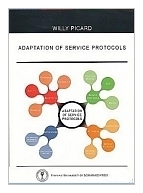ADAPTATION OF SERVICE PROTOCOLS
The originality of the proposed solution comes from the interdisciplinary naturę of
service protocols and their adaptation based on the integration of the process approach,
the service-oriented paradigm, and networks, especially social ones. Another original
aspect of Picard's approach is the fact that the proposed adaptation method is both
normative and collaborative, encompassing human factors, such as tacit knowledge and
social relations, that are not supported in purely technical systems.
From a review by Professor Jerzy Brzeziński
The originality of the results of Picard's works comes from a generalization of the
service-oriented paradigm to support the collaboration of people, information systems
and/or organizations. [...] Picard demonstrates that protocols are a universal approach
that can be applied to both global and local organizations.
From a review by Professor Jerzy Świątek
Translated by Poznań University of Economics Press
Introduction 11
Acknowledgements 19
I. THE PROBLEM 21
1. BACKGROUND 23
1.1. Networks 23
1.1.1. Fundamental Definitions 24
1.1.2. Representations of Networks 25
1.1.3. Social Network Analysis 31
1.1.4. Social Reąuirements 33
1.2. Service Orientation 34
1.2.1. Service-Oriented Architecture(s) 34
1.2.2. Web Services 40
1.3. Computer Support for Humań Interactions 52
1.3.1. Workflow Management Systems 52
1.3.2. Business Process Modelling 53
1. 3. 3. Adaptive Case Management 53
2. ADAPTATION MODELS AND METHODS 55
2.1. Classification of Adaptation Models and Methods 56
2.2. Adaptation of Complex Systems 56
2.2.1. Characteristics of Complex Systems 56
2.2.2. Examples of Complex Systems 57
2.2.3. Network-based Approaches 60
2.2.4. Agent-based Approach 61
2.3. Adaptation of User Interfaces 62
2.3.1. Context-Aware Development Approach 63
2.3.2. Model-based Development Approach 64
2.4. Adaptation of Business Processes 67
2.4.1. Process Lifecycle in Process Aware Information Systems 67
2.4.2. Adaptation vs. Flexibility vs Evolution 69
2.4.3. The ADEPT Project 71
2.4.4. The "Pockets of Flexibility" Approach 73
2.4.5. Adaptive Service-Oriented Architecture 74
2. 5. Evaluation of Adaptation Models and Methods 81
3. RATIONALE FOR THE ADAPTATION OF SERVICE PROTOCOLS 84
3.1. Motivation 84
3. 2. Requirements 86
II. THE PROPOSED SOLUTION 87
4. SERVICE PROTOCOLS 89
4.1. The Concept of a Service Protocol 89
4.1.1. Example 1: Clearance of a Construction Site 89
4.1.2. Keylssues 90
4.1.3. Goals of Service Protocols 92
4.1.4. Reąuirements for Service Protocols 93
4.2. Fundamental Definitions 94
4.2.1. Object-oriented Graphs 94
4.2.2. Processes 97
4.2.3. Services 97
4.3. Formal Model of Service Protocols 98
4.3.1. Overview of Service Protocols 98
4.3.2. Service-Oriented Summary of a Process Model 99
4.3.3. Service Network Schema 100
4.3.4. Service Protocols 105
4.4. Summary 108
5. ADAPTATION OF SERVICE PROTOCOLS 110
5.1. The Concept of Adaptation of Service Protocols 110
5.1.1. Example 2: Removal of Dangerous Chemicals 110
5.1.2. Key Issues 112
5.1.3. Goals of the Adaptation of Service Protocols 114
5.1.4. Reąuirements for the Adaptation of Service Protocols 115
5.2. Formal Model of Adaptation of Service Protocols 116
5.2.1. Overview 116
5.2.2. Meta-Protocols 117
5.2.3. Adapting Statements 119
5.3. The Meta-Protocol Markup Language (MPML) 122
5.3.1. Data Model 122
5.3.2. Meta-Protocol Pointers 146
5.4. Summary 150
III. APPLICATIONS 151
6. AGILE COLLABORATWE NETWORKED ORGANIZATIONS 153
6.1. Collaborative Networked Organizations 154
6.1.1. Rationale for Collaboration among Organizations 154
6.1.2. Organizational Structures Supporting Collaboration among Organizations 156
6.1.3. Defmition of Collaborative Networked Organizations 157
6.2. Service-Oriented Virtual Organization Breeding Environments 158
6.2.1. Virtual Organization Breeding Environments 158
6.2.2. The Service-Oriented Architecture Perspective 161
6.2.3. Definition of Service-Oriented Virtual Organization Breeding Environment 162
6.2.4. Classification of Services in a Breeding Environment 162
6.3. Agility in Service-Oriented Virtual Organizations Breeding Environments 163
6.3.1. Agile Creation of Collaborative Networked Organizations 163
6.3.1. Prescriptive modelling 163
6.4. Summary 168
7. AGILE CONSTRUCTION SUPPORT FOR REAL-ESTATE DEVELOPERS 170
7.1. Selected Characteristics of the Construction Sector 171
7.1.1. Complexity of the Development Process 171
7.1.2. Heterogeneity of Real-Estate Developers 174
7.2. Modelling Interactions during the Construction Phase 176
7.2.1. Characteristics of Interactions during the Construction Phase 176
7.2.2. Contract-based Service Protocols 178
7.3. The ErGo System 181
7.3.1. Overview of the ErGo System 181
7.3.2. ErGo Applications 182
7.3.3. Architecture 191
7.3.4. Implementation 192
7.4. Summary 193
8. CONCLUSIONS 195
Appendix 1. Overview of the Meta-Protocol Markup Language 199
Appendix 2. XML Schema of the Meta-Protocol Markup Language (MPML) 200
Appendix 3. An Example of a Meta-Protocol Serialization 214
Bibliography 236
Index 257
List of Figures 263
ListofTables 263
List of Listings 264
262 pages, Paperback
Księgarnia nie działa. Nie odpowiadamy na pytania i nie realizujemy zamówien. Do odwolania !.


